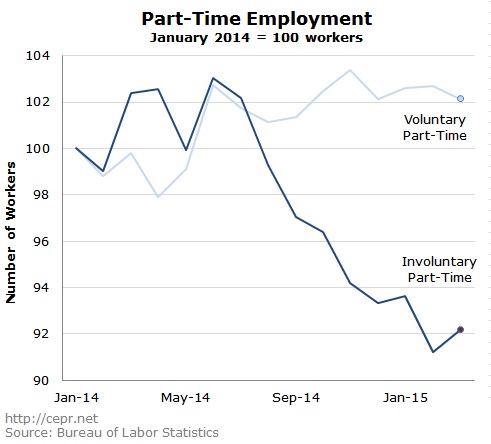April 03, 2015
April 3, 2015 (Jobs Byte)
By Dean Baker
The Labor Department reported the economy added just 126,000 jobs in March, its weakest showing in two years. Downward revisions to the prior two month’s data brought the three month average to 197,000.
Clearly, weather played an important role in the weaker-than-expected report, as much of the Midwest and Northeast was hit by unusually severe weather in the second half of February and early March. As a result, construction lost 1,000 jobs after adding an average of 36,000 jobs in the prior four months. Manufacturing also lost 1,000 jobs after adding an average of 21,000 in the prior four months. Restaurants added 8,000 jobs in March, compared to an average of 43,000 a month from October to February. While all of this slowdown was not due to weather, it was an important factor.
Some other sectors, most notably mining, showed weakness that was not primarily weather-related. Mining lost 11,100 jobs in March — 1.3 percent of total employment — a decline which was undoubtedly due to the plunge in world oil prices. The government sector also shrank slightly, losing 3,000 jobs due to a decline of 4,000 in state-level employment.
Job growth in the health care sector slowed to 22,000 in March after averaging 39,000 the prior four months. Temp employment rose by 11,400, but most of this was just reversing a decline of 7,500 reported for February. In keeping with its recent pattern of strong growth, the professional and technical service sector added 23,700 jobs in March, only slightly below its 31,000 average for the prior four months.
There were some positive items in the report. Self-employment is up by 250,000, roughly 2.0 percent, from its year-ago level. This is a possible dividend of the end of health-care-related job lock due to the Affordable Care Act. Voluntary part-time employment fell slightly in March, but is still up by more than 900,000 (at 5.0 percent) from it level of two years ago. Involuntary part-time rose slightly in March, but is down by almost 1.0 million from its level of two years ago.

Also, there was a plunge of 5.0 percentage points in the unemployment rate of black teens to 25.0 percent. This is the lowest level since October of 2002. Most likely this is anomaly that will be reversed next month, but if part of the drop sticks, it does mean a serious gain. In this respect, it is worth noting that the employment-to-population ratio (EPOP) for black teens actually fell by 1.1 percentage points.
The share of unemployment due to people voluntarily quitting their jobs remained at 10.2 percent. This is the high for the recovery, but still well below pre-recession levels. All the long-term duration measures of unemployment fell in March, with the share of long-term unemployment dropping 1.3 percentage points to 29.8 percent.
In another likely anomaly, the number of discouraged workers was 40,000 higher than the year-ago level. This is the first year-over-year increase since January of 2014. All of the rise was among men.
There does finally appear to be evidence of accelerating wage growth. The average hourly wage over the three months from January to March rose at a 2.8 percent annual rate compared with the average for the prior three months. This compares to a 2.1 percent rate over the prior twelve months. This is consistent with the announcements of pay increases by several large employers of low-wage workers. In this respect, the pay of non-supervisory workers in retail rose at a 3.7 percent annual rate over this period, although the increase in the restaurant sector was just 2.1 percent. Hourly wages for all restaurant workers rose at a 3.0 percent rate over this period.
It is always difficult to read a report that was clearly skewed by weather. Clearly the underlying rate of job growth is faster than the 126,000 reported for March; however, it would not be surprising if employment growth did slow. An economy that is likely growing at close to a 2.5 percent rate would be expected to only generate around 120,000 jobs per month. The fast job growth of the last two years was associated with extraordinarily weak productivity growth.






